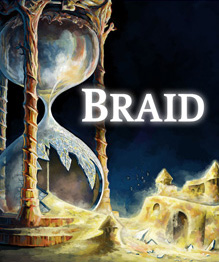
Braid : A 2D platformer with sinister arthouse intentions.
Story : A young chap named Tim made some kind of mistake and is trying to rescue a princess from some kind of monster…
…or that’s what you’re led to believe. This game takes a Killer7 approach to game design in that not everything is what it seems, rather that there’s some kind of hidden truth behind all of these goomba-stomping levels. Braid reminds gamers that the potential for storytelling in video games is nowhere close to fully tapped, in part thanks to an incredible end game sequence. There’s also an affinity for abstract imagery, in that the game has several text sequences, “paintings” and such that flesh out the themes of each level and give some insight in the life of this Tim fellow.
But man does this game love making you read. Whether or not there’s much value in all of this reading is another question. The aforementioned texts at the start of each level are meant to give emotional value to that level’s gimmick, but don’t advance whatever plot is actually present in the game. Rather, the only actual story twist is the above mentioned end game sequence, and if the game ended with that, then I would’ve been able to walk away and label Braid as a work of genius. Instead, Jonathon Blow decides to crap all over things in an attempt to take the symbolism one step further. After the end, the player is treated to many, many more blocks of text that, essentially, explain to the gamer (or should I say “the reader”?) that the entire game is meant to be symbolism for another, seemingly unrelated story. I can’t help but find this to be a slap in the face, belittling to the adventure I thought I was on, moreso than the Super Mario Bros 2 “it was all a dream” end sequence. This aspect feels pretentious, unnecessary, and the whole game could’ve been stronger without it.
The well-dressed schoolboy manner of Tim, combined with the painting-esque art style, the puzzle-solving focus and the decided lack of guns anywhere in the game give me the impression that this game is trying to reach out to a more civilized gamer of either gender and not just testosterone-driven 13 year old males like pretty much every other game, and I respect that. The driving concept behind the game is that Tim here can rewind time to his heart’s content. The game creates the idea that you’re not supposed to die, rather, should an evil rabbit off you, time can be rewound to a safer point. The goal of each level is to collect puzzle pieces that ultimately form some kind of image, with each puzzle piece requiring the player to overcome some kind of abstract puzzle, demanding a degree of outside-the-box thinking. Each world also has its own gimmick to complicate the matter, from platforms that can’t be affected by rewinding to the entire flow of time moving back and forth based on what direction you’re walking in. For the most part, every single platforming puzzle is ingeniously designed, and you’ll feel a great sense of accomplishment in collecting that seemingly out of reach piece. Even the moments where I caved and looked up a strategy guide left me looking at certain pieces and thinking to myself “wow, that’s actually pretty ingenious.” And besides, should you screw up, the solution is typically a quick rewind away.
…and that’s Braid in a nutshell. Five worlds of clever puzzles that push the notion that games can be a powerful means of interactive storytelling… or at least until the game strays and tries to be even more than it should be. If Jonathon Blow’s intention all along was to preach about the Manhattan Project, then I feel like he should’ve just written a short story of some kind, because that’s what you’re getting at the end. Placed in the context of the rest of the game, this alternate story feels tacked on and existing only to downplay what is otherwise a potentially powerful yet minimalist story of love gone wrong. As for the rest of the game, buy it if you like the idea of solving very well-designed puzzles, but between the story issue leaving a bad taste in my mouth and the notion that a solved puzzle can no longer challenge you, I doubt I’ll be spending any time revisiting Braid. The game costs 1200 Microsoft points, which will set Canadians back about $20, and I personally don’t think that the game is worth it.
Pros : Effectively uses aspects from Super Mario Bros for imagery.
Cons : Who’s idea was it to throw in invisible stars? Seriously?
3 ½ stars.
I don’t feel like a big guy for picking on an “independent” game. Not that this game screams “independent” when you look at its budget.

No comments:
Post a Comment